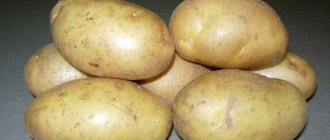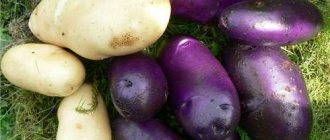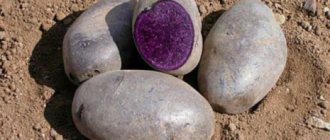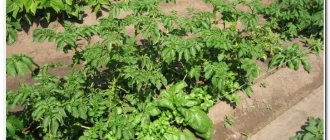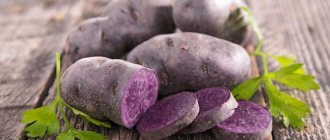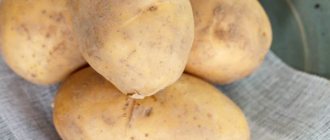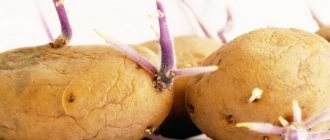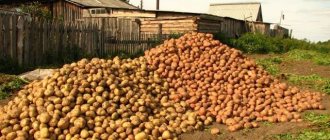There is an opinion that the best variety of potatoes is the one that can be stored for the longest possible time and throughout the winter you don’t have to worry about the tubers spoiling or rotting, since potatoes are rightfully considered the best ingredient for any side dish. Mashed potatoes, roast potatoes, jacket potatoes, baked or stewed - whatever your heart desires, the main thing is that you can grow exactly the potatoes that will most successfully convey the skill of the hostess, emphasizing the incredible taste of the main dish.
It is reliably known that most consumers prefer to make bulk preparations of vegetables for the winter in mid-autumn, especially for potatoes. The market is rich in different varieties, shapes and colors, but often all this fades into the background, since it is important for people that the potatoes have a pleasant taste and can “feed” the whole family until the new harvest. Accordingly, gardeners strive to grow only those varieties that they not only like, but are also in demand on the market. We present a list of potato varieties that are rightfully considered the best, because they not only have a pleasant taste, high yield, but also store well all winter and more.
Potatoes are different
The main feature of potato tubers is their content of dry matter, or more precisely, starch. The more starch there is in the tuber, the faster the potatoes will boil during cooking (during boiling or frying). Based on this, foreign potato producing companies label their products with Latin letters from A to D.
- For salads and soups, potatoes with the letter A next to the variety name are most suitable;
- for chips, a low-cooking variety is ideal, which is marked with the letter B;
- well-cooked potatoes are suitable for frying and deep-frying - this is the letter C;
- For casseroles and mashed potatoes, you need to buy potatoes with the letter D in the name.
Today, most domestic producers of seed material and potatoes for food also label their products according to this classification.
If the potato variety is older, the starch content may be indicated as a percentage. You need to be guided by the fact that for frying they use potatoes with an approximate proportion of starch of 15%, and for mashed potatoes you need to take a variety with at least 25% of the dry matter in the tuber.
Based on the above, we can conclude that each gardener will have to plant several varieties of potatoes at once, because there is no universal root crop suitable for both purees and salads.
In addition, there are potatoes with red or white skin. In principle, the color of the tuber does not affect either the keeping quality of root crops or their taste, so this factor is not important in choosing a variety.
Timing of ripening of root crops
But the timing of potato tuber ripening plays a major role in choosing a variety for storage. It is believed that mid- or late-ripening potatoes can last the longest, while early-ripening root crops will last in the basement until November at most.
For storage, you need to choose potatoes that reach technical ripeness on the 100-130th day after planting in the ground. Such potato roots ripen better, have thicker skins, are better able to tolerate diseases and viruses, and contain more tannins.
Varieties of potato varieties
When first learning about the wide variety of types of root vegetables, it is difficult to figure out which of them are intended for food use and which are suitable for animal feed:
- Dining room. A common species that differs in taste. Used in cooking.
- Technical. Contains a small amount of protein. Designed for the production of starch and alcohol.
- Stern. Used for animal feed. It is distinguished by a high level of protein and starch.
- Universal. Suitable for any application.
By ripening periods
There are many types of different root crops, differing in terms of ripening:
- Early. A summer vegetable that is immediately eaten. The fruits ripen in fifty to sixty-five days.
- Mid-early. Can be stored for a short time, preferably refrigerated. Ripening occurs within 65-85 days.
- Mid-season. You can save it, but it sprouts quickly. Develops within 95-115 days.
- Medium late. Long-lasting, matures in 95 days or more.
Many people are interested in the best varieties of early potatoes in order to eat vegetables faster in the summer. Here are some of them:
- Timo;
- Riviera;
- Lapis lazuli;
- Ariel;
- Impala;
- Sturdy.
According to taste properties
The taste of vegetables is the main reason why summer residents cultivate potatoes. The tuber is suitable for different uses: one for mashed potatoes, another for first courses, and from the third you can make a salad using the raw root vegetable.
Delicious varieties of potatoes:
- Lasunok;
- Picasso;
- Aurora;
- Blue;
- Vesnyanka and others.
The volume of starch in the root vegetable
Tubers become soft during heat treatment if they contain starch:
- a root vegetable with a lower starch content is suitable for first courses and salads;
- Potatoes with medium content are used for frying.
Increased volume – more than 25 percent. The maximum amount of starch is 14-25 percent. The minimum starch content is 10-13 percent.
Potato varieties with the maximum amount of starch:
- Lorch;
- Crane;
- Stonefly;
- Atlant;
- Asterix;
- Bryansk is reliable.
What kind of potatoes can last all winter?
When determining the variety of potatoes for storage, it is better to play it safe and buy 2-3 types of root vegetables at once, especially if the gardener has not had to deal with these varieties before.
It is unknown how potatoes will behave in specific conditions, because several factors are important for the keeping quality of root crops:
- The type of soil in which potatoes will grow. It is known that the best, most delicious and ripened root vegetables can only be collected from sandy soil. While peat garden plots are unsuitable for growing this vegetable. Potatoes grown on peat will be tasteless and will not last until spring. These root vegetables can be distinguished by black dust on the peel. Loamy and chernozem soils are well suited for growing potatoes, but in the latter there is a high probability of infection of root crops, since all microorganisms and viruses multiply very quickly in chernozem.
- Weather conditions also affect the quality of potato roots and their ability to be stored for a long time. It is believed that too much rainfall affects not only the taste of the fruit (potatoes in this case will grow “watery”), but increased humidity will lead to premature damage to the crop. Potatoes collected from wet soil will definitely not be stored for long - such root vegetables will begin to rot and deteriorate very quickly.
- Pests and diseases significantly reduce the ability of the potato crop to be stored in winter, because damaged potatoes can last much less than whole ones. Therefore, before storage, the harvest must be sorted, damaged potatoes and those that were lying nearby (they could also become infected) must be removed.
- To prevent infection with late blight, it is necessary to maintain normal humidity, not to thicken the plantings too much, and regularly treat the bushes with fungicidal preparations. Late blight on root crops is quite difficult to determine - it does not appear outwardly. But, if a cut potato has black spots inside, it will not be stored, and it is impossible to eat it.
- The gardener's excessive use of nitrogen fertilizers and pesticides also affects the keeping quality of the potato crop. Such potatoes have too delicate skin and a watery core, and for storage you need elastic potatoes with a hard center.
- Harvested too early is also unsuitable for winter storage. Such root vegetables have not yet acquired a thick skin; their skin is too tender and flaky. During storage, the potatoes will become limp and soft and begin to rot.
- The greenish skin of the potatoes indicates that the fruits were too close to the surface of the ground or “peeled out”; as a result, the potatoes received sunburn. You cannot store or eat such root vegetables, because they contain toxic substances - alkaloids.
To summarize, we can say that potatoes are needed for winter storage:
- with late ripening;
- grown on good crumbly soil;
- fully matured;
- dry and clean;
- healthy and without signs of damage.
If the last four factors depend on cultivation methods, weather conditions and timely harvesting, then the choice of variety is entirely in the hands of the gardener himself.
How to choose potatoes for the winter
In order to create a strategic reserve until the next harvest and not expose your body to danger, you need to take care of preparing good-quality tubers for the winter. The State Veterinary Medicine Service answered the most popular questions about choosing potatoes for the winter. What varieties of potatoes are best for storage?
For winter storage, you should choose not one variety of potato, but two or three. There will be a higher probability that at least some of it will survive until spring. When choosing from white or pink varieties, it is better to give preference to white ones: these potatoes are more stable. “White” is considered to be a potato with a light skin, but its shades vary. Late varieties are stored much better. The most delicious potatoes that grew on the sand. It is crumbly, starchy and aromatic.
But potatoes from peat bogs, due to the increased content of nitrogen compounds, taste worse and are less healthy. You can run your hand over the tuber - if you feel grains of sand, you can take it. You can identify a peat plantation by the black color of the dust on the potato skins. Good potatoes grow on loams and black soils. If gray or brownish plastic dirt has stuck to the potatoes, these potatoes are perfect for winter storage. How to choose potatoes by appearance?
It’s good if the potatoes are clean and dry, without soil residues - this indicates that they were harvested during dry times. If the product is wet and the earth is stuck to it, then the harvest occurred during the rainy season, and the potatoes have absorbed moisture, so such potatoes will not last long in winter. Make sure there are no greenish barrels. To begin with, it’s worth buying a couple of kilograms for testing. Cut the potatoes and look for rot or dark spots inside. You can simply smell the tubers - they should not smell unpleasant. A foul odor may indicate that the root crops are grown in soil with low oxygen content. But such potatoes do not last long in winter.
Large potatoes are easier to peel, which is why most people buy them. However, small ones are usually cheaper. Opinions are divided regarding its usefulness. Some experts believe that medium and small potatoes contain more nutrients, and large fruits are a sign of excessive application of mineral fertilizers. Others advise choosing only large potatoes, since large tubers have time to ripen better, which means they contain more vitamins and protein, they are tastier and healthier. Avoid potatoes with thin, flaky skin. This is a sign that the tubers are not ripe and storing such potatoes in winter will lead to losses. Ripe potatoes have a smooth, thick skin that does not peel off. Should I buy washed or unwashed potatoes?
The same varieties grown under the same conditions are sold in unwashed and washed form. True, during the washing process, potatoes are sorted and defective and non-standard specimens are removed. Therefore, the risk of buying sick or spoiled products here is minimal. But washed potatoes store worse, so for a “strategic reserve” for the winter it is better to buy unwashed tubers. You should not buy potatoes for winter storage directly from the field - if the tubers have just been dug up, then you cannot take them to the basement for storage. Before storing the potatoes, they should rest for two, or better yet, three weeks. What diseases can potatoes have?
When purchasing, the first thing you need to do is check if there are any green specimens among the tubers. Green color indicates the presence of alkaloids. These are toxic substances that are formed in tubers when exposed to sunlight. “Green” potatoes should not be eaten. Potatoes can be affected by late blight. Externally, diseased tubers look quite attractive, but inside the potatoes are blackened.
It is almost impossible to notice late blight from the outside, so you should ask the seller to cut a suspicious specimen. If the “autopsy” gives a disappointing result, you cannot buy such potatoes. Other potato diseases can be identified by eye. Small round holes indicate that this potato was riddled with wireworms. Brown spots on the surface are scab disease. Grooves filled with soil - the potatoes are damaged by the larvae of the May beetle. How to test potatoes for nitrates?
It is easy to determine that potatoes were grown on mineral fertilizers, including nitrogen fertilizers. You need to try picking at it with your fingernail. If it easily entered the tuber, you should not take such potatoes. Another sign of excess nitrates is moisture oozing from the cut. Natural potatoes are elastic, juice does not leak from them, and when the skin is damaged, a characteristic cracking sound is heard. Of course, you can accurately determine the amount of nitrates only if you have a nitrate meter.
And even if after all the checks there are still doubts about the quality and safety of potatoes, then you just need to ask the seller to show an expert opinion from the state laboratory of veterinary and sanitary examination on the agri-food market. This document confirms that these products have passed all the necessary tests, are approved for sale and found suitable for human consumption.
Opinion - October 09, 2021 2903
Tags: Agriculture
We would be very grateful if you share this news on social networks
Late potato varieties
Late-ripening potatoes will be stored much better and longer than other varieties. In addition, such root vegetables are more saturated with useful microelements than others. For winter storage, it is better to choose two or three varieties of potatoes at once in order to find out which of them will last until spring with the least “losses” and continue its cultivation next season.
"Picasso"
A potato variety of Dutch selection, which is classified as late-ripening - root crops ripen by the 130th day after sowing. The bushes of this plant are medium-sized, not very spreading, the blooms are white. The root vegetables themselves are oval, smooth and uniform. The peel is beige in color, the eyes are colored pinkish, and are located at the same level as the peel. When cut, the potato is cream-colored.
Each bush ripens about twenty root crops, the average weight of which is 100 grams. The starch content is low, these potatoes are most suitable for making soups and frying, they do not boil well. The taste is good, the tubers are aromatic.
The variety is perfect for the climatic conditions of the Moscow region and the southern regions of the country. The tubers are stored well and for a long time, the plants tolerate periods of drought and extreme heat well, and rarely get sick.
It is recommended to plant root crops at a sufficiently large distance from each other, otherwise the potatoes may “climb” to the surface and spoil due to excessive crowding. Another feature of the variety is its susceptibility to late blight infection; plantings must be protected from excessive moisture.
To obtain a bountiful harvest, it is recommended to grow these potatoes in an intensive way - using organic and nitrogen supplements. For storage purposes, there is no need to fertilize the bushes.
"Crane"
A Belarusian potato variety that ripens quite late - after 130 days of growing season. The bushes are of medium height, slightly spreading, blooming with bright purple inflorescences.
Root vegetables are round in shape and differ in that they have different sizes - each bush can have up to 18 potatoes of different weights (from 100 grams or more). The color of the peel is red, the eyes do not protrude above the surface and are at the same level as the peel. In cross section, the root vegetable is yellow in color.
The starch content is quite high; these potatoes are suitable for mashed potatoes, potato pancakes, and chips. The potatoes taste very good and have a special potato aroma.
A distinctive feature of the variety is its unpretentiousness. These potatoes, even with minimal participation from a gardener or summer resident, will give a good harvest. The plant is resistant to most potato diseases, including scab and late blight. This allows for minimal processing of the bushes; they will only have to be protected from pests.
Before planting the tubers in the ground, they need to be warmed up for several weeks. To do this, potatoes intended for planting are taken out of the basement and placed in a warmer place.
“Crane” is stored well; during the winter the root crops do not get sick or rot.
"Asterix"
This variety is considered medium late. The plants are tall, the bush is erect, the potatoes bloom with red-violet inflorescences.
Root vegetables are oval-shaped and elongated. The peel is colored red; when cut, the tuber is yellow in color.
The starch content is average (at 16%), which allows Asterix potatoes to be used for frying and deep-frying, as well as for the production of chips. The taste characteristics are good. The average weight of root vegetables is about 100 grams. Potatoes are resistant to mechanical damage and can not only be stored for a long time, but also transported over long distances.
The variety is highly resistant to viruses and diseases - bushes and root crops rarely get sick. Product quality is excellent.
"Blue"
The variety is named after the blue-blue inflorescences that bloom on the bushes. Plants of medium height, spreading. Potatoes ripen in an average time - 100 days after planting.
Potatoes are round in shape and painted white, both outside and inside. The root crops are quite large - the average weight of each is about 150 grams, this determines the high yield of the variety (up to 500 centners per hectare of land).
The tubers cook well and have an excellent taste. Potatoes are suitable for making mashed potatoes and casseroles, as well as for frying. At the same time, the variety has good commercial qualities and increased resistance to viruses and pathogens.
Mid-late growing season, tall, branched bushes with soft green leaves and red-violet inflorescences are the characteristics of the Lorch potato.
Root vegetables can be either round or oval. The peel is beige in color, the flesh is almost white.
Potatoes weigh from 100 to 120 grams. The variety is distinguished by high yield and good keeping quality. The starch content is high, which means the potatoes will boil well.
This variety is not afraid of late blight and viral diseases, however, you should be wary of scab and cancer.
"Atlant"
Belarusian potato variety, characterized by medium-late ripening. The root vegetables are round in shape and brownish in color. The starch content is quite high - from 16 to 20%, which allows the crop to be used for frying and making purees.
Potato pulp does not darken in air; it can be used to make potato pancakes, and on an industrial scale it can be processed to produce starch. The taste of the tubers is quite high.
The variety is perfectly protected from viral and bacterial diseases. However, it does not tolerate too wide plantings and waterlogged soil.
"Vesnyanka"
Round potatoes of a light pink color, with creamy flesh and faint eyes. These potatoes contain a lot of starch - up to 20%, ideal for making mashed potatoes.
The variety is very unpretentious to the composition and type of soil, tolerates drought and abundant moisture, and is protected from most diseases and viruses. Another feature of tubers is that they tolerate winter well. Before planting, potatoes need to be germinated.
Resistant potato varieties
Varieties with certain characteristics are suitable for winter storage:
- Resistant to late blight. Otherwise, in winter you can observe a beautiful, smooth peel, but blackened flesh.
- With optimal starch content. The more dry matter there is in potato tubers, the longer the crop can last. To determine which varieties of potatoes are best stored, you should familiarize yourself with the rules for labeling vegetables. Manufacturers use Latin letters to label varieties. Designations are selected depending on the percentage of starch. The letter A, placed next to the name, indicates the suitability of the variety for soups and salads. Low-cooking varieties are marked with the letter B; they are suitable for making chips. The letter C means the potato variety is suitable for frying. Potatoes for mashed potatoes and casseroles are marked with the letter D
- Mid-late or late ripening. These varieties of potatoes, if the storage parameters are observed, will last until spring. Early potatoes are stored for 2-3 months after planting.
- Keeping quality. The characteristics are laid down by the breeders, but depend on the conditions created for the tubers for storage.
Compliance with agricultural technology
Another significant factor is compliance with agricultural techniques for growing potatoes. Shelf life is also influenced by weather and climatic conditions. The harvested potato crop is difficult to preserve in the following cases:
- Rainy and cold summer. During this period, with high humidity, the tubers are saturated with moisture, so storage losses increase by 1.5 - 2 times.
- Growing vegetables on heavy clay soils. Light sandy loam is suitable for the crop. If the area has peat soil, the peel of the vegetable will have a black tint. Such root vegetables do not last long. It is believed that vegetables, including potatoes, should be grown on black soil. But in such soil, pathogenic microorganisms multiply quickly, which increases the risk of tuber infection.
- Excessive amount or deficiency of fertilizers. Excess nitrogen leads to an increase in sugar content and damage to tubers by storage diseases. When overdosed, the tubers have a watery core and thin skin. Lack of potassium is the second reason for poor shelf life.
- Affected by late blight. To reduce the risk of tuber disease, tops are removed from the beds before digging.
- Failure to meet harvest deadlines. Potatoes harvested early are covered with a delicate skin that rots during storage.
- The presence of greenish skin on the tubers. This color appears when potatoes are sunburned. Toxic substances are formed in root vegetables, which makes them unsuitable for consumption and storage.
- Cleaning in damp, humid weather. Tubers rot and spoil after a short time.
Based on the above, a conclusion should be drawn. After harvesting, potatoes lie well if:
- a late ripening variety was selected, other varieties have reduced storage time parameters;
- grown on fertile crumbly soil;
- fully matured – harvesting deadlines are met;
- collected in dry weather;
- has no damage or disease.
Vegetable growers do not recommend storing tubers of only one variety of potato . The combination of 2-3 species increases the likelihood of the crop being preserved until spring. Confidence that the tubers will survive the winter comes from sorting the root crops into good specimens and lesser quality ones. The latter are set aside separately for immediate use.
Recommendations for storing potatoes
In order not to lose a good harvest during storage, you need to follow simple rules:
- Potatoes must be stored at a temperature of +2 degrees, air humidity should be at 80-90%. The ideal place to store potatoes is the basement.
- Potatoes are stored in wooden boxes with ventilation holes, placed on pallets and moved 10-15 cm away from the walls. This will prevent the root crops from getting wet and freezing.
- Once or twice during the winter, the crop is sorted, removing rotten specimens and potatoes that have sprouted.
- If the potato harvest is stored on the balcony, it should be covered with warm rags or blankets to prevent freezing and exposure to sunlight.
- After harvesting, the harvest is not immediately lowered into the cellar; the potatoes must be ventilated for two to three weeks.
- You cannot store potatoes with other vegetables and fruits; only beets are suitable as a “neighbor” for this crop (it absorbs excess moisture from the air).
Choosing storage space
- Consecration. Light will lead to the formation of a toxic substance - solanine. And storing potatoes on a loggia risks exposing the tubers.
- Room temperature. A very low value may result in spoilage of vegetables. The most optimal temperature is +2, +4 degrees. Based on this, you need to choose a room where you can create all the required values.
- Air humidity should be between 87-90 percent. A slight deviation of these indicators from the required norm can lead to a decrease in shelf life and also in the quality of tubers. The premises should be selected based on their required recommendations.
Finally
Thanks to this article, you could learn a lot of useful information. And now we offer you to see potato varieties that store well in winter. So this is the variety:
- Gatchinsky,
- Zhuravinka,
- Zdabytak,
- Saturn,
- Atlant,
- Asterix,
- Gull,
- Bernadette,
- Yavir,
- Kolobok,
- Blue,
- Slav,
- Vesnyanka,
- Lorch,
- Folfa et al.
See also video:
Studying the peel
When making bookmarks for storage, many people prefer large tubers. But, as a rule, they contain fewer nutrients, although this does not greatly affect the taste. Therefore, for the winter it is better to select medium-sized potatoes that fit in your hand. This will make it easier to clean.
“Young or completely unripe potatoes, dug up before the tops have dried out, have thin and flaky skin. The maturity of the root crop is indicated by a thick and smooth peel, says agricultural producer Hakim Nazar from the Chelyabinsk region . “Such potatoes will taste better and will last longer during the winter.”
Potato variety Lorch
Lorch is one of the best varieties of potatoes, which not only stores well all winter, but also boils well during the cooking process. This variety is rightfully considered a medium-late variety, since full maturity occurs no earlier than after 120 days. During this time, tubers with an average weight are formed, reaching 95-120 grams. The Russian breeders who developed this variety planned to use it not only in cooking, but also in industrial processing, since the presence of starch is very high and amounts to up to 20%. A very important fact is the absence of darkening of the peeled tubers, which also cannot but please consumers. The tubers are formed in a regular oval shape, and have an excellent combination of light yellow skin with a whitish tint of pulp. Growing the Lorch variety is not very troublesome, but you need to take into account that temperature changes do not have a very favorable effect on the harvest, but increased moisture is the best conditions for the development of this variety. Long winter storage and excellent taste cannot leave consumers indifferent, so this variety has more than enough fans.
Growing potatoes for personal use or for sale must be justified by long-term storage, so planting these particular varieties in the coming season is a wise decision.
Join our Facebook group
We buy after drying
The taste of potatoes is largely influenced by the soil in which they grew. It is better if it is sandstone or black soil. Then the tubers will ripen starchy, and when cooked they will be crumbly and aromatic. But peat soils, due to their high nitrogen content, are not suitable for this agricultural crop. Potatoes grown in peat bogs will taste like soap. By color, such defective goods can be distinguished by their too dark, almost black peel.
“The potatoes collected from the field must be sent to dry for several weeks. Constant ventilation in such special industrial storage facilities removes excess moisture and thereby strengthens the peel, explains the Chelyabinsk farmer. “Therefore, always ask whether the potatoes have been lying around since they were dug up or whether they were brought from the field.”
Frying and puree varieties
It is a misconception that pink-skinned potatoes are only suitable for livestock feed. Both white and yellow potatoes, as well as pink ones, can have excellent taste. The whole secret is in the variety. According to Hakim Nazar, one of the best is Gala. Potatoes of this variety are white-skinned and yellow inside - firm, but not crumbly. A variety with pink tubers, “Red Scarlet,” is well suited for boiling and mashed potatoes.
“There are now many German potato varieties on the market: white-skinned Natasha, Queen Anne, Granada and red-skinned Rosara and Red Lady. White varieties, as a rule, have excellent taste, but are poorly stored, warns General Director of the State Unitary Enterprise “Food Corporation of the Chelyabinsk Region” Irina Novikova . – “Natasha” is amazing for making purees, it boils well. Granada is very good for frying. Therefore, when purchasing white-skinned varieties, use them before January - February. Red-skinned varieties have universal properties and are stored very well until August – September of the next season.”
Domestic varieties such as “Babushka”, “Mirage”, “Souvenir”, “Cornflower”, “Fritella” and “Charoit” also have excellent taste.
The best mid-season and late crumbly potato varieties with white flesh
Sineglazka (Russia)
- Ripening period : 70-90 days (mid-season).
- Tubers : oval-round, with a thin but very dense skin of a yellowish-pink color. The variety got its name due to the blue eyes on the surface. Tuber weight 70-195 g.
- Starch content: 11-14 %.
- Culinary type : AB
- Productivity : 120-293 c/ha, maximum - 478 c/ha.
- Disease resistance : resistant to cancer, scab, late blight, susceptible to nematode.
- Growing regions : Central.
- Advantages : low maintenance, high yield, good shelf life (93%)
- Disadvantages : not very good marketability (75-88%).
Important : Although the Sineglazka variety is a medium crumbly variety, we mentioned it in this article, since many users consider it very boiled and say that mashed potatoes are better and tastier than those made from this potato!
Photo gallery of potato variety Sineglazka:
Aurora (Russia)
- Ripening period : 70-90 days (mid-season).
- Tubers : oval, yellow skin with a small number of reddish eyes. Weight 93-128 g.
- Starch content: 13,5-17,3 %.
- Culinary type : VS
- Productivity : 214-396 c/ha.
- Disease resistance : high to cancer, nematode, moderately susceptible to late blight of tops and tubers.
- Growing regions : Northern, Northwestern, Central, Volga-Vyatka, Central Black Earth, North Caucasus, Middle Volga, East Siberian, Far Eastern.
- Advantages : good yield, unpretentiousness to growing conditions, high shelf life (94%).
- Disadvantages : relatively long germination, average marketability (80-93%).
Photo gallery of the Aurora potato variety:
Vestnik (Russia)
- Ripening period : 80-100 days (mid-season).
- Tubers : round, weighing 48-140 g, cream-colored skin, mesh texture.
- Starch content : 11.2-18%, 0.6-1.6% higher than standard.
- Culinary type : VS
- Productivity : 158-307 c/ha.
- Disease resistance : resistant to cancer, viruses, can be severely affected by late blight.
- Growing regions : Central.
- Advantages : stable yield, good taste of tubers, resistance to mechanical damage, good shelf life (94%).
- Disadvantages : average marketability (77-93%), not resistant to late blight.
Photo gallery of potato varieties Vestnik:
We study for diseases
When buying potatoes from producers whose reputation you are confident in, make sure there are no diseases. The first sign that something is wrong will be green tubers. This indicates that they contain a large amount of the alkaloid solanine, which is toxic to humans, which serves to protect the plant from bacteria and insects.
Small round holes indicate that a wireworm managed to feast on these potatoes. Brown spots are signs of scab; such tubers are unsuitable for food. Large grooves filled with earth are traces of the larvae of the May beetle - the beetle. However, the most common potato disease is late blight. With it, the tubers look healthy on the outside, but are blackened inside. Therefore, always ask the seller to cut the potatoes. By the way, there is no need to buy copies with mechanical damage either.
The potato crop has more than four thousand varieties. They differ in taste, size, peel color, and ripening time. Also one of the main parameters is the keeping quality of the vegetable. The ability of potatoes to retain their external and taste properties until spring is very important.
When choosing the most suitable potato variety for winter storage, you should be guided by a number of factors, and also follow recommendations for creating optimal conditions in storage.
Preparing vegetables for the winter
The potato storage process consists of three stages:
After harvesting, potatoes must go through all three stages.
Drying potatoes
Treatment occurs during the drying period of the tubers. First, the crop is left on the ridge for initial drying. Tubers need 1.5 - 2 hours. Then the collected potatoes are laid out in one layer in a place with air humidity of 95% and a temperature of +13°C...+15°C, and left for 1.5 weeks. During this time, damage caused during cleaning heals. At the same time, the peel becomes coarser. Potatoes become less susceptible to injury. After a week and a half, the vegetables are sorted out, putting rotten specimens aside. Potatoes selected for storage are placed in containers.
Cooling of root vegetables
After the root crops have fully ripened, you need to wait until the metabolic processes stop. To do this, the temperature at the location of the tubers is gradually lowered. The process lasts 1.5 - 2 weeks, every two days the indicator is reduced by 1°C. The lower limit is +1°C, humidity – 90%. At this stage, you should protect the potatoes from moisture. Chilled root vegetables have a full supply of nutrients, which is preserved throughout the entire storage period.
Choosing storage space
In the storage room it is necessary to ensure the following basic indicators:
- Lack of lighting. Exposure to light leads to the formation of a toxic component - solanine. Storing on the balcony risks exposing the potato crop.
- Room temperature. A low value leads to spoilage of tubers, an increased value leads to germination. +2°С…+4°С is considered optimal. Therefore, you should choose a room where you can provide the required values or adjust them in a timely manner.
- Air humidity is needed in the range of 85% - 90%. Deviation of the indicator from the norm will lead to a decrease in the shelf life and quality of the product.
The room is selected in accordance with the recommendations to preserve the potato harvest.
Today there are more than four thousand varieties of potatoes. They all differ in peel color, root size, ripening time and taste. When choosing potatoes for your plot, you need to be guided by another quality of the vegetable - its keeping quality. After all, potatoes must last until spring in order to “feed” the summer resident and his family until the new harvest.
What does keeping quality depend on?
Many factors influence the long-term shelf life of potatoes. Let's look at them in order.
Genetic characteristics of the variety
Depending on the timing of ripening, the following varieties are distinguished: early, mid-ripening and late. The former are suitable for consumption in summer and autumn, since they can generally be stored only until November. And the second two can last until spring.
Weather
With heavy rainfall, oxygen is displaced from the soil, and the tubers “suffocate,” which become more easily infected with diseases during further transportation and storage. If the summer was cool and rainy, potato losses may increase by one and a half to two times.
Soil Features
Potatoes grown on light sandy loam soils store well. The crop also grows well, producing a high-quality harvest, on black soil and peat soil.
Fertilizer application
The correct use of mineral fertilizers is very important. With an excess of nitrogen, tubers contain more sugars, which increases the intensity of respiration and, as a result, susceptibility to disease. Also, a lack of potassium fertilizers leads to deterioration in keeping quality.
Harvesting
Timely harvesting of potatoes and proper preparation for storage are no less important. The optimal time for collection is when the air temperature is not lower than +5°C, and the soil temperature is above +8°C.
After the potatoes are selected from the ground, they should be left at the digging site for 1-2 hours. Then the tubers are removed for 2 weeks to dry, for example, under a canopy. And only after this can you transfer the potatoes to their wintering place.
Storage conditions for table varieties
Don't lose sight of the quality of the potatoes you plant in winter. It should be intact, clean, unsprouted, ripe, with a thick peel. This one lasts much longer.
The optimal temperature regime for most varieties is +2…+4 °C. However, there are more capricious ones that require other conditions. For example, Lorch, Start, Razvaristy are better preserved at +3...+5 °C, and Falensky, Epron, Northern Rose - at +1.5...+2 °C.
Appearance and variety of potatoes
There are a lot of potato varieties, but not all of them are equally well suited for winter storage. The most suitable for this are mid-season and late varieties. The early ones are more intended for current use. They do not last long, beginning to deteriorate soon after being placed in storage.
By assessing the appearance of the tubers, you can roughly determine the suitability of the potatoes for winter storage. Unwashed potatoes are more suitable for buying for future use; they last much longer. You should also pay attention to such product characteristics as:
For storage, choose clean potatoes without external damage.
- tuber size – medium-sized potatoes are more suitable for long-term storage. Large tubers may end up with a “surprise” inside - hollow, rotten or diseased;
- density and hardness of the product - some softness indicates an excess of fertilizers used in growing the crop, or the beginning of the development of rot;
- integrity of the tubers - there should be no cuts or other mechanical damage on the potatoes, such a product is not stored for long and begins to rot quickly;
- color and condition of the potato peel - the skin of the tubers should be free of green and dark spots, dense, smooth and without peeling. A thin, flaky skin indicates that the harvest is too early, when the tubers have not yet ripened.
Attention! Potatoes that have turned green are unfit for consumption. It contains poison, which in large quantities is dangerous to humans. When purchasing potatoes for winter storage, tubers with green spots should be discarded. If there are a large number of them, it is better to purchase the product elsewhere.
Why are mid-late and late varieties recommended for wintering?
Potatoes that ripen 100-130 days after planting in the ground have a thicker skin, which protects them from mechanical damage during harvesting and transportation.
In mid-late and late ripening varieties, there is an increased content of protective substances, which contribute to better resistance of tubers to diseases. Therefore, they are well stored in winter.
What climatic features are taken into account when choosing potato types?
The plant can be grown throughout most of Russia. Most of the root crops are cultivated in the Central regions. Thanks to the loose soil and favorable climate, potatoes produce large yields there.
In the northern regions, early and mid-season vegetables are grown. They have time to ripen thanks to the bright summer months.
In the Trans-Baikal Territory, tubers are planted in ridges. In the North-West, they practice planting sprouted tubers, while late-ripening varieties are avoided due to the short summer period. When purchasing planting material, you should pay attention to the recommended cultivation areas and buy adapted species.
The best varieties of potatoes for long-term storage: features and photos
So, let's look at which varieties are better stored in winter and are also resistant to rot and other diseases.
Slav
Mid-season (ripening time 100-120 days), table purpose, grown almost everywhere and has a fairly high yield (300-330 c/ha). The bush grows up to 12-15 large tubers weighing 90-180 g. Thanks to its unpretentiousness, this variety is not afraid of changeable weather.
It has a high shelf life (95%) and retains its taste and appearance throughout the entire storage period. Slavyanka is immune to potato cancer, leaf curl, blackleg, nematode, and is moderately resistant to late blight.
Nevsky
Mid-season, high-yielding (380-500 c/ha), table. It is considered the best of the domestic ones; its yield is close to that of the Dutch. Ripening time is 70-85 days. Each plant produces 9-15 tubers of 90-130 g each. Keeping quality is 92-95%. Cultivation is preferable in regions with sandy loam soils and light loams. Moderately resistant to scab and late blight.
Gatchinsky
Mid-season Russian table variety with excellent yield (400-450 c/ha) and keeping quality at 94%. Preferred regions for cultivation are Northwestern, Central, Volga-Vyatka, North Caucasus, Middle Volga, Lower Volga, Ural, Far Eastern.
Resistant to potato canker, relatively resistant to late blight of tops and tubers, common scab, and blackleg. The presence of starch at the level of 12-16%, is universal in terms of cooking methods, as it is suitable for frying, boiling, baking and making purees.
Sante
Mid-season, Dutch, with a yield of up to 570 c/ha. Ripens in 85-90 days, each bush will produce up to 20 tubers weighing 90-120 g. Keeping quality is slightly lower than the varieties listed above - 92%.
Recommended for growing in the central zone and southern Russia. The immune system is not resistant to late blight and scab. Due to its low starch content (10-14%), it is suitable for frying and making French fries.
Adretta
Mid-season, German selection (vegetation period 70-105 days) with a yield of up to 450 c/ha. The number of tubers on a bush is from 15 to 25, weighing 120-150 g each. It has a very high level of keeping quality - 98%.
Suitable for cultivation in the Central, Far Eastern, Middle Volga, Western Siberian regions and Crimea. However, it is susceptible to scab, rhizoctonia, and late blight. The percentage of starch is increased (13-18%), so these potatoes are suitable for serving as mashed potatoes or whole for frying.
Atlant
A late-ripening winter variety of Belarusian selection (ripens in 110-120 days) with extraordinary productivity (up to 660 c/ha). Tubers of 90-120 g each ripen in the amount of 7-11 pieces per bush. It also has excellent keeping quality - 95%.
Contains a lot of starch (15-21%), so these potatoes are very soft and ideal for mashing and baking.
Another variety of Belarusian selection is a mid-season variety (ripens in 80-90 days) with a yield of up to 680 c/ha. Highly resistant to potato canker, scab, blackleg, but at the same time moderately resistant to late blight and rhizoctonia. Characterized by good keeping quality. Due to its fairly low starch content (10-14%), it is best suited for frying.
Kolobok
Mid-season (growing season 90-115 days) with a yield in the range of 130-250 c/ha. Each bush ripens up to 15-18 tubers weighing 90-140 g. It has a long shelf life, without losing its appearance and taste for a long time. The best regions for cultivation are Central and Central Black Earth.
Kolobok is highly resistant to potato cancer, scab, and various viruses, but can be susceptible to nematodes and late blight. The starch level of 13% to 15% makes it most suitable for the production of potato products (chips, freeze-dried mashed potatoes, mixed vegetables, frozen French fries).
Potato variety Picasso
Picasso - this variety stands out not only for its excellent characteristics, which lead to long-term storage, but also for the highest possible yield. This variety is a late variety, since the period of full ripening is almost 130-145 days. But it is precisely this fact that helps the tubers not to lose their shape, taste and aroma for a long time during basement storage. The variety is considered Dutch, therefore it is known and widely used throughout the world. The tubers are not large in size, round, slightly elongated in shape. The surface is quite smooth with an original color, where pink “spots” are placed on a yellowish background. The pulp, on the contrary, has a tender and juicy surface with a beige color. The tubers actually grow to a moderate size and range from 80 to 160 grams. But the yield exceeds all usual standards and amounts to 18-20 tubers per bush. Thanks to the not very high starch level - 7.5-14%, the taste is at a high level. Moreover, the variety is perfectly stored all winter with minimal losses and damage. The main thing is to create the right conditions under which the tubers will be neither hot nor cold. When planting in open ground, remember that this variety must have sprouts, because without germination the tubers will remain “sit” in the ground without any development. The Picasso variety is an impeccable leader due to its taste, high yield and excellent long-term storage.
List of varieties that will not last long
Alena, Ariel, Zhukovsky early, Impala, Lileya, Uladar, Riviera, Timo, Karatop, Rosara, Bellarosa, Zhavoronok, Romano are examples of varieties that will delight you with their early harvest. They ripen from 45 (for ultra early) to 80 days (for mid-early). But these potatoes definitely should not be left for long-term storage - due to the thin skin, the tubers quickly lose moisture, become lethargic and tasteless.
Among the variety of potato varieties, you can choose exactly those that last best in winter - these are mid-season and late-season. In addition, it is worth focusing on the genetic characteristics of a particular variety, since some of them have increased resistance to diseases, viruses, and wet rot.
But it must be remembered that the initial quality of the tubers, as well as the correct storage conditions, will be no less important for the long-term storage of potatoes in winter.
If you find an error, please select a piece of text and press Ctrl+Enter.
Recommended varieties for the Middle Zone
To plant potatoes in the middle zone, you need to use early and mid-early planting material. Early potatoes are used for food; they are not suitable for storage. And the mid-early ones can be saved.
The best potato varieties for the middle zone include the following:
- Tuleevskaya. Mid-season, ripens in 85-105 days. The weight of one potato is 150-260 grams, and can reach up to half a kilogram. The rind has a lightened coffee tint and the inside is white.
- Nevskaya. The interior and crust are white. Weight reaches up to 135 grams. Well preserved.
- Sorcerer. Medium late. Ripening time is 85-95 days. The weight of the marketable vegetable reaches 85-125 g. The rind and interior are yellow.
- Luck. The vegetable is flat oval in shape. Reaches a weight of 125-140 g. It is stored in winter.
Sweet
Do you use folk signs in gardening?
Several varieties of potatoes that have a sweet after-cooking flavor:
- Adretta - early ripening. The fruit is dark yellow in color, its weight reaches 130-135 grams. The ripening period is 64-85 days.
- Vineta – early ripening, high-yielding. The tuber is yellow in color, weight – from 65 to 105 grams. Vegetation period is 65-70 days.
- Zekura is precocious. The dense peel is yellowish in color, weighs 100-190 g. Ripens within 95-110 days.
- Santa is thermophilic. The fruits are yellow, weighing up to seventy grams. Ripens within 85-90 days.
- Symphony – red crust. The ripening period is 95-11 days. The weight of the root crop reaches from 70 to 140g.
For frying
Sometimes after frying the potatoes turn out to be stewed. Varieties more suitable for frying:
- Rosara. Grows in any climate. The surface is pink or reddish in color, the inside is yellow. Ripens in two and a half months. The weight of one potato is 100-125 g.
- Anosta. Potatoes were imported from Holland. The peel and pulp are yellow in color. The weight of one root vegetable is 70-135 grams. The growing season is 75-80 days.
- Ariel. Has a balanced taste. Time to ripen - 65-78 days. Smooth, neat shape of the vegetable, weight from 85 to 175 g. The root vegetable has a yellow tint on the outside and a light yellow color on the inside.
For cooking
Some types become soft during heat treatment. You will learn from this list which varieties of potatoes are best for mashed potatoes:
- Riviera. The rind is light yellow in color, the flesh is granular. The weight of the fruit is 120-140 grams.
- Bellarosa. The fruits are reddish and have a rough surface. The weight of one vegetable is 115-210 g. It ripens within 44-60 days.
- Tiras. Pinkish surface, weight ranges from 115 to 150 grams. Ripens in 85-90 days.
For long-term storage
Vegetables of mid-season and late-season varieties are preserved for a long time. They have a thick peel and a high composition of microelements.
Among the best varieties of potatoes for winter storage, we can recommend the following types:
- Lorch. Medium late. Snow-white peel, white interior. Weight from 95 to 120 g.
- Bryansk is reliable. A mid-late variety vegetable. Vegetation period – 96-115 days. Weight 85-125 g. Surface – red, inside – white.
- Stonefly. Late ripening. Oval-round tubers. Ripens: 115-125 days. The rind is yellow, the flesh is creamy.
- Atlant. Late. Vegetation occurs within 115-125 days. Weight 95-125 g. The surface is yellow, the inside is light yellow.
- Asterix. Late. Ripens in 100-110 days. Tuber weight 85-115 g. The rind is pinkish-violet. The interior is bright yellow.
- Crane. Medium late. The growing season is 110-125 days. Weight from 95 to 160 g.
- Loshitsky. Medium late. The surface is white, the inside is light yellow. Weight 95-110 g.
Salad
Salad root vegetables contain little starch. Delicious in any form. The salad and vinaigrette are prepared from varieties that have red, blue and purple flesh. The brighter the color of the potato, the greater the amount of useful elements it contains.
Popular varieties of this potato:
- Red Scarlet. Preserves and tolerates short-term drought. The rind is red, the inside is yellow. The growing season lasts up to 80 days. Weight up to 125 grams.
- French truffle. It has an original purple color both outside and inside. Suitable for making salads and vinaigrettes, does not boil over. You need to clean it after it cools down. The fruits are small, weighing up to 75 grams. Late variety. It is grown by hand in small beds. Potato seeds are expensive.
Dietary
There are varieties suitable for dietary and baby food. These include:
- Gypsy. Thin and delicate, purple peel. The interior has a delicate taste, white or cream color. Average weight: 110-130 grams.
- Aladdin. Medium late. The rind is pinkish, the interior is white. Ripens within 95-110 days. The weight of one vegetable is 100-175 g.
- Sifra. Medium late. The rind is golden, the flesh is snow-white. Pleasant, sweetish taste, does not darken when cooked. Weight – 100-150 grams.
Productive
All gardeners are interested in productive varieties of potatoes. With uncertain farming and capricious weather, it is not desirable that regular cultivation of the soil, control of weeds and pests results in a small harvest: less than what was planted. Therefore, choosing potato varieties is a major task that requires serious study of growing methods.
These varieties include:
- Idaho. Early ripening. They are resistant to diseases.
- Bela Rosa. The tuber is oblong in shape. The weight of the vegetable is two hundred to five hundred grams.
- Picasso. Late ripening. Ripens in 115-130 days. The outside color is pink-yellow. Weight from 110 to 145 grams. The pulp is white-yellow in color. The taste is pleasant. To be stored.
- Gala. Imported from Germany. Delicious. The rind and interior are yellow. The weight of the root crop is 70-135 g. It ripens in 80 days.
